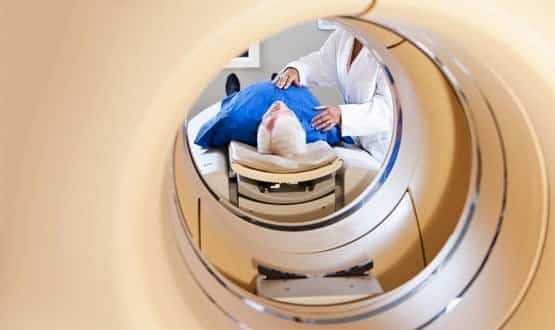Measure for measure
- 18 January 2013

Radiologists face a balancing act when it comes to making sure that they are using an adequate amount of radiation to work as a diagnostic tool, while minimising the risk of radiation-induced cancer for the patient.
According to UK Health Protection Agency, patient radiation exposure has been falling steadily. Comparison of like-for-like x-ray examinations shows that dose levels are now half of those used in the 1980s.
This is good news, but there is still much progress to be made to bring radiation dose levels down in UK hospitals.
Most notably there are still wide variations between institutions, which need to be addressed through improved regional and, ideally, national, automated data collation and reporting.
In summer 2012, the Department of Health commissioned a working party that produced an information paper on digital analysis and reporting systems for diagnostic radiation doses.
Primarily, this was aimed at radiology and medical physics staff procuring x-ray / computed tomography equipment, picture archiving and communications systems, or dose data analysis systems.
However, it was also timely because of the refresh of the PACS/RIS market that is underway, as the local service provider contracts for these systems come to an end over the next three years.
From an information technology perspective, reducing radiation dosage requires efficient systems to be designed and implemented for automated dose monitoring, so comparisons can be made between procedures and modalities in different institutions, new and old equipment, and cumulative dose over time on a patient basis.
Sweden’s model for automated dose monitoring
Countries across Europe are all at different stages of implementing automated radiation dose reporting, but overall, it is still a relatively new practice. Sweden has proven to be a leader in this field.
One of the most recent systems to be launched at the 2012 Radiology Society of North America meeting was Sectra’s automated dose monitoring system, known as DoseTrack.
Dr Peter Leander is regional chief radiology officer, Skåne Region, and associate professor in radiology at Lund University, Sweden.
He is heading up the implementation of DoseTrack across ten hospitals in southern Sweden. DoseTrack provides the facility to both gather and compare radiation dose levels and observe trends such as between hospitals and between equipment.
“Also, our aim is to ensure that the referring physician can directly see the dose that a patient is receiving and has received in the past,” says Leander.
“We currently have the database and now this needs to be used in a smart way – that is to enable referring physicians to see dose history.”
There are several automated dose-monitoring systems on the market but according to Leander, smart implementation of these systems still requires some development to ensure patients receive a reduced dose of radiation whilst ensuring diagnostic quality.
“Most vendors of PACS/RIS are usually required to provide a facility for dose monitoring as an option these days,” he remarks.
Another advocate for automated dose monitoring is clinical physicist and radiation protection adviser Dr Peter Hiles from North Wales Medical Physics, Glan Clwyd Hospital.
He has been involved in the PACS renewal process for NHS Wales. He says that trusts undergoing PACS contract procurement would be wise to incorporate a facility for automated dose monitoring.
“Now really is the best time to do it. It’s an easy add on for a PACS. It will also become a valuable tool in the future.”
The DH information paper
The UK, more generally, is taking steps to gradually improve automated dose monitoring.
A spokesperson for the 2012 DH Working Party said the information paper it produced was aimed at “standardising the methods of digitally recording the factors or parameters relating to dose data.”
In its information paper, the working party concluded that:
* Healthcare providers should be informed of the interoperability standards and scientific and clinical limitations of software to store and analyse data
* A wide stakeholder group needs to be convened to explore broader requirements for the future so dose data can be collected on a larger scale
* An output-based specification for the second wave of PACS has been written including a requirement for PACS to conform to the Integrating Healthcare Enterprise Radiation Exposure Monitoring integration profile.
Amongst other aspects of automated dose monitoring, the paper discusses the technical information and features to be considered by trusts and private healthcare providers to avoid use of inappropriate dose alerts and dose accumulation features that might harm patients.
In the few months that the paper has been available, feedback suggests that, “radiology and medical physics staff welcome this guidance because it facilitates radiation dose parameter recording locally and allows medical physics staff to analyse the data, identify trends and take action to reduce radiation doses.”
On a wider scale, collation of the locally gathered data into a national database could make a significant contribution to public health as analysis of national trends and radiation dose in general could be reduced, adds the Department’s spokesperson.
Also sitting on the working party was Niall Monaghan, chief executive of Radiation Consultancy Services and past user co-chair of IHE-UK (Integrating the Healthcare Enterprise UK).
Monaghan is committed to facilitating the move to more universal automated dose monitoring, but highlights that real radiation risk level is difficult to measure.
Devices attached to x-ray tubes can measure radiation dose on a case-by-case basis or dose information can be accurately calculated by the modality, and this can be stored alongside the patient image file.
“Ideally, when we do an x-ray or CT scan we want to know that the doses being given are at an acceptable level roughly equal to doses given at other centres [within the national diagnostic reference levels and as low as reasonably achievable within these DRLs],” says Monaghan.
“This provides a means of identifying whether one establishment may have a problem with equipment, protocol or technique.”
The HPA has been collating manually generated national dose information for the past 25 years. However, these days, dose data are more often generated at the modality level.
They can be stored in the DICOM header and made available as a DICOM dose-structured report, but this needs to be collated at a cross-institutional level. “This is the information we want to get at and analyse to understand the extent of radiation exposure across the country,” says Monaghan.
What are UK hospitals using to automatically monitor radiation exposure?
Despite this enthusiasm, and the working party’s work, the uptake of automated radiation dose monitoring in the UK is mixed.
According to Monaghan, some hospitals use commercial software that works with CT, fluoroscopy and radiography systems and records data via a DICOM dose-SR. Other hospitals use bespoke DICOM analysis software packages, written in-house.
“Both have the ability to retrieve dose information either from the DICOM header or by calculation based upon exposure parameters or even from optical character recognition (OCR) of modality-provided dose information.”
One other hospital is known to use RADIANCE, an open-source software pipeline designed to automatically extract and archive CT dose-related parameters from dose sheets using OCR. Yet another institution is considering a GE product called GE Dose Watch.
With the growing need for enhanced and standardised methods of automated dose monitoring, suppliers of imaging equipment are starting to welcome ‘compliance’ as a sales feature.
This raises the possibility of providing accurate patient dose history, identifying poorly performing high dose equipment, and poor technique or protocols; all with a click of a mouse.
Hiles says that the move towards automated dosing in the UK is a positive step for radiation monitoring.
“There’s the element of the data being more robust when automated because the scanner is talking directly to the database rather than being fed in by a member of staff at a later date.
This is an important element of this, which will make it a far more useful system than we’ve had to date.”
He adds that automated monitoring allows them to obtain more accurate data. It provides a lot of further information beyond just how the data was acquired. “It allows one to ask why is that happening? It compares parameters. It’s definitely the way forward.”
At St George’s Healthcare NHS Trust in London, Dr Johnny Vlahos, consultant radiologist, is using the GE Healthcare automated dose monitoring system to compare patient dose on CT scanning machines from different manufacturers and generations of the same scanner.
The trust started using DoseWatch in February 2012. It has enabled the team to monitor all examinations and look for outliers indicating patient protocols or individual patients receiving higher doses than might be expected.
“We subsequently used the technology to optimise the dosimetry for multiple different CT protocols in order to consistently deliver diagnostic information at a minimum dose,” Dr Vlahos says.
Despite a constantly monitored CT practice, use of DoseWatch has identified unexpected variances in CT exposure and enabled St George’s to homogenise practice whilst also reducing dose for some examinations by up to 30%.
"It is now difficult to imagine returning to a practice situation where we did not have the continued backing of this essential tool,” Dr Vlahos adds.
Wales at the forefront
Wales is one of the first, if not the first area in the UK, to actually start implementing automated dose monitoring on a national basis. The NHS Wales PACS renewal arrangement has written automated dose monitoring into the deal that it has signed with FujiFilm.
“We have software being included in our PACS that is being installed. It should be up and running by April,” says Hiles.
The installation will cover the whole of Wales. Along with medical physics colleagues across Wales, the new PACS will cover the whole area and compare regions, and compare the same scanner in different areas.
Of course, in practical terms, dose-monitoring systems are only as good as the system in place to analyse, report and take action on the data available.
In Wales, there is a central server and their automated monitoring software can be interrogated for required information and automatically provides reports.
Leander says the next step for the system in Skåne is to create a position for a medical physicist on the central committee to take responsibility for DoseTrack to reporting and analysis of the data.
Reflecting Hiles’ thoughts about the wealth of information that could be revealed through the automated dose software, Leander says: “I think it’s a great advance to have these types of automated dose monitoring systems but we are still in the early stages.”
This is true internationally but never more so than here in the UK. By all accounts, reducing patient radiation exposure and dosing is largely data-driven: until there is an accurate record of the amount of exposure patients are receiving then the size of the problem often remains little more than an educated guess.
The HPA says it will publish an assessment of radiation doses from CT scanning later this year – this will be a good place to start.




